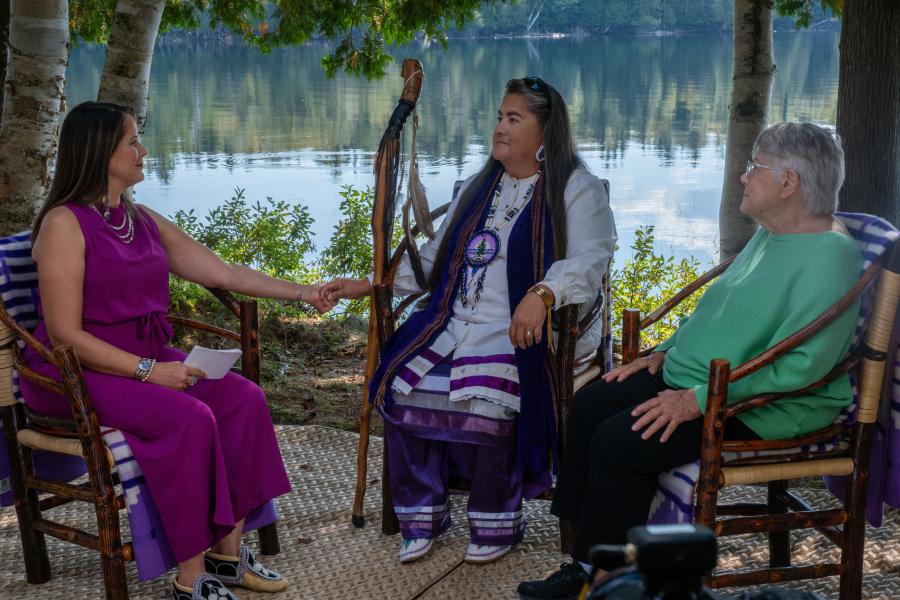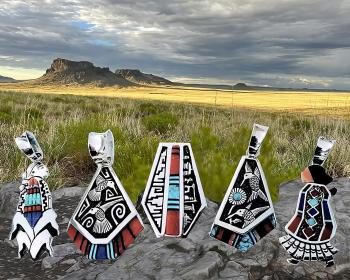The Navajo Nation and the Hopi Tribe are awaiting the outcomes of negotiations with Peabody Coal Company over use of the Navajo-aquifer in Black Mesa, Arizona. To many of the region’s 30,000 residents who rely on the N-aquifer as their primary water source, Peabody’s operations are environmentally and culturally unacceptable.
When Peabody began strip-mining Black Mesa land in 1968, they constructed a 273-mile long pipeline between the coal-rich area and the Mojave Generating Station in Laughlin, Nevada. Transferring the coal as slurry through this pipeline requires approximately 3,800 acre-ft of water annually – water that is pooled from eight wells tapping into the aquifers that lie beneath Black Mesa.1
In 1971, the Navajo and Hopi tribes began questioning the availability and the quality of their water in light of Peabody’s continued withdrawals. These doubts launched investigations of the water source by the U.S. Geological Survey, the Arizona Department of Water Resources and the Bureau of Indian Affairs.2
With their latest report released on March 22nd of this year, Peabody concluded that long-term water use “will not significantly affect the integrity of the 7,500 square-mile aquifer or surrounding community water supplies.”3 The report affirmed that Peabody mining will use less than one-tenth of 1 percent of the total water volume stored in the N-aquifer for the duration of their work – an amount they say is equivalent to displacing less than half of a beverage can from a 55 gallon drum.
Executive Vice President for Peabody’s legal and external affairs, Fredrick Palmer, additionally noted that “the pipeline system continues to be the most environmentally sound way to convey coal to the Mojave power plant. Palmer also claims that the aquifer system will appreciably recover when pumping ends.4
But the Navajo and Hopi communities state their claims just as adamantly. Hopi Chairman Wayne Taylor Jr. said that ‘the N-aquifer is a limited source of water that is threatened by the estimated population growth for both tribes.5 Taylor asserted that there is an urgent need to find an alternative water source for the Peabody Coal Company’s use.
Furthermore, the position taken by Chairman Taylor is supported by the significant decision made by the Navajo Nation Council. On July 25tth 2003, in a vote favored by 48, with 12 opposing and 11 abstaining, the Council officially voted to end the pumping of the N-aquifer on Black Mesa by 2005. The passing of this resolution was initiated without legal consultation – a move that sparked a split response.
Among those applauding the act are Nicole Horseherder and Marshall Johnson, coordinators of To’ Nizhoni’ Ani, a community-based organization devoted to terminating Peabody’s pumping of water for coal transport. Horseherder has made clear that her organization is working hard to provide solutions to the N-aquifer problem by recommending alternative power sources that do not drain Black Mesa’s water.
Alternatives for consideration include: 1) reclaimed water from surrounding cities, 2) the Integrated Gasification Combined Cycle, or, smaller power stations that burn cleaner coal using almost no water, and 3) contracting with the state of California for renewable energy.6 This plan would allow the energy to be sold to the states currently buying energy from California Edison, owner of the Mojave Generating Station.
In addition to providing constructive alternatives, Horseherder also denounces a main proposal being considered by the Navajo Nation – replacing the N-aquifer with the Coconino Aquifer (C-aquifer). The C-aquifer covers 27,000 square miles and is located beneath the N-aquifer.7 Horseherder notes that acquiring the funds for the environmental study and approval required to make the switch seems unfeasible due to objections from California Ratepayers and Utility Workers Union.
Navajo Nation President Joe Shirley, Jr. has expressed his concern over the July 25th resolution, however, in that it did not pass through his office prior to ruling by the Council. He exclaimed regret that the Council “did not heed the advice of the Attorney General of the Navajo Nation or its own Water Commission as to the impacts the resolution may have on negotiations with Peabody and with the efforts to find an alternative to the N-aquifer.”8
Shirley also stressed the importance of avoiding any mine shutdown in the process of negotiation, and reassured miners that the Navajo Nation is working hard to find an alternate power source. He noted, “The impact of such an action would be devastating. The Navajo Nation could stand to lose up to $35 million dollars in revenue, over 740 jobs and of course, loss of other benefits to the affected communities.”9 Income from Peabody accounts for approximately 4/5 of the Hopi Tribe’s budget and 1/3 of the Navajo Nation’s budget.10
In hopes to maintain an economically beneficial relationship with Peabody, Navajo and Hopi representatives have shown great support for the C-aquifer alternative. Hopi Chairman Taylor stated that “the C-aquifer will provide Peabody with the water source they need for slurrying coal, allowing both the Hopi Tribe and Navajo Nation a guaranteed source of drinking water to sustain our villages and future economic development.”11
Hopi Vice Chairman Caleb Johnson has suggested yet another possibility: a railroad as a completely water-free transportation system. Taylor said that though the idea has merit, it has been estimated that it would cost five times more than the C-aquifer pipeline, making it highly impractical. The tribe would pay a part, but the federal government would have to fund the rest – an unlikely prospect. Additionally, a spokeswoman for Peabody, Beth Sutton, remarked that the railroad option was considered years ago, but a U.S. Department of Interior report “rejected the idea as environmentally intrusive and not economical.”12
Despite the negative response to the railroad proposal, Vernon Masayesva, Executive Director of the Black Mesa Trust, a grassroots organization dedicated to stopping the Peabody pumping, has taken a strong position in its favor. In a recent interview, he emphasized the lack of respect for water today: “[Water] is sacred – without it, there is no life. The sooner people realize this, the better off they’ll be.”13
Masayesva supports the railroad alternative, and explained that its large expense stands out because the Hopi and Navajo currently subsidize the pipeline system – a setup that would not carry over in the overland construction.
Postscript: In its latest advancement, the N-aquifer issue was discussed at the most recent Navajo Nation Water Rights Commission meeting in Tuba City. The C-Aquifer option was on the agenda along with California Edison’s necessary plant shutdown on January 1, 2006, as it cannot meet the December 31st, 2005 deadline for a pollution protection upgrade.14
The Black Mesa Weavers for Life and Land is one of Cultural Survival’s 17 global outreach programs and supports alternatives to the pipeline. As a project that aims to improve economic and social conditions of the Black Mesa Dine through preservation of traditional livelihood, they have declared:
“Black Mesa Weavers for Life and Land calls for and supports the end of Peabody Coal pumping water from the N-Aquifer, the sooner the better. While coal is still being mined, we urge the substitution of a non-water source - such as railroad, conveyor belt, or truck transport - to move any coal mined from the Peabody Black Mesa mine lease area. At the same time, we urge that all parties concerned explore and seek to develop other sources of renewable energy, such as solar, which should eventually be used to replace the burning of fossil fuels to generate electrical power.”15
For more information, please refer to the following website:
1. U.S. Geological Survey. “Monitoring the Effects of Ground-Water Withdrawals from the N Aquifer in the Black Mesa Area, Northeastern Arizona.” March 1999.
2. Ibid.
3. “Peabody Releases Latest Black Mesa Aquifer Study; confirms prior studies showing no significant harm.” March 22, 2003.
4. Ibid.
5. Bindell, Stan. “Chairman: Hopi, Navajo must join on aquifer plan.” The Gallup Independent. August 27, 2003.
6. Horseherder, Nicole. N-Aquifer Editorial. September 2003.
7. Shebala, Marley. “Council votes against use of Navajo Aquifer.” The Navajo Times. July 18, 2003.
8. “Council moves to end water use by Peabody; Dine Prez alarmed,” The Gallup Independent. August 12, 2003.
9. Ibid.
10. Maniaci, Jim. “Water Rights Commission Takes its Program to Western Agency.” The Gallup Independent. October 9, 2003.
11. Bindell, Stan. “Chairman: Hopi, Navajo…” The Gallup Independent. August 27, 2003.
12. Ibid.
13. Interview conducted by Gabrielle Berlinger, 10/1/2003
14. Maniaci, Jim. “Water Rights Commission …” The Gallup Independent. October 9, 2003
15. Halberstadt, Carol. “Beautiful Spring Speaks: A Resolution to Save the Navajo Aquifer.” April 25, 2003.



